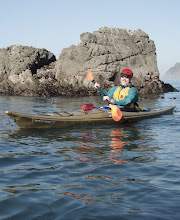The first thing I did was to get the strongback level by using shims under the legs of the stands. That way, I could insure that if a form was vertical, it was square to the strongback and aligned vertically with all the other forms.
The next thing I did was to clamp a small frame to the end of the strongback and use a plumb bob to line up a nylon line vertically with the centerline on the strongback, as show in this picture. I used a dab of hot glue to hold the nylon line in place on the frame.
As I mentioned, the holes in the forms were oversized, so I needed a way to position each one so that it lined up vertically and horizontally with the other forms and also to tilt it one way or the other. The method I ended up using involved clamps and a piece of angle aluminum. That way I could raise one or both sides of the form and slide it left or right as I needed. I marked a center on the angle aluminum so that I could line the center of the form up with the center line on the strongback.
I used the nylon line to visually line each form with the others. In this photo, I have a clamp holding the nylon line at the top of the the centerline of the form I'm adjusting. I visually line up the nylon line with the centerlines of all the forms. If it does not align, I move the form I'm working on until it does. Once the form is aligned I secure it to its cleats with hot glue.
Once I had a form aligned I checked to make sure it was vertical and that it was square with the box beam. If it needed a little adjustment, I used shims of posterboard (i.e. little chunks of cereal boxes) to get the alignment spot on. Once there, I secured it in place with a couple of clamps and hit it with several spots of hot glue.
Once all the forms were secured with hot glue, I checked the alignment with the string and also by visually aligning the the other marks on the forms. Most of them were aligned perfectly, but for a couple, I had to break loose the hot glue and realign them.
Once all forms on the strongback were properly positioned, I secured them in place with drywall screws.
The end forms were much easier than I had expected. I glued the perpendicular forms to the larger form that is parallel to the centerline, using clamps to hold them in place. When they were dry I used small pieces of angle aluminum to secure the larger ones. I then took the whole assembly, lined it up with the rest of the forms using string and eyesight, clamped them in place, secured them with hot glue, then used sheetrock screws to shore them up.
this photo shows the strongback with all forms aligned, secured, and taped on the edges so that when I glue strips into place they won't stck to the kayak.
Getting the forms aligned and secured was a large pain in the butt. Some of the lessons I learned were:
- Be patient. You will get it done even if you have to backtrack and redo and backtrack and redo. There is no point in beating yourself up over your mistakes. Let it be fun.
- Hot glue is your friend. It holds things in place, but can be undone. You can knock parts loose with a mallet, cut it with a chisel, or cook it with a heat gun until it melts again and softens.
- Aquarium tubing with water in it does not make a precise enough level. I tried this at first, but the tubing could move up or down by about a quarter of an inch before the water would move. Had I used this to line up the forms, the kayak would be messed up.
- A nylon line, even stretched tight, will sag. I used a stretched line to draw a horizontal line on the side of the strongback. When I checked this by measuring, I could tell it had sagged in the middle. I rotated the strongback so that the side was on top. When I stretched the line again, it confirmed that the line had sagged.
- Buying an aluminum box beam saves time. In my case, lots of time.
- When you get the forms aligned and secured, you realize that you really are going to be able to build your kayak. And that is a good feeling.







